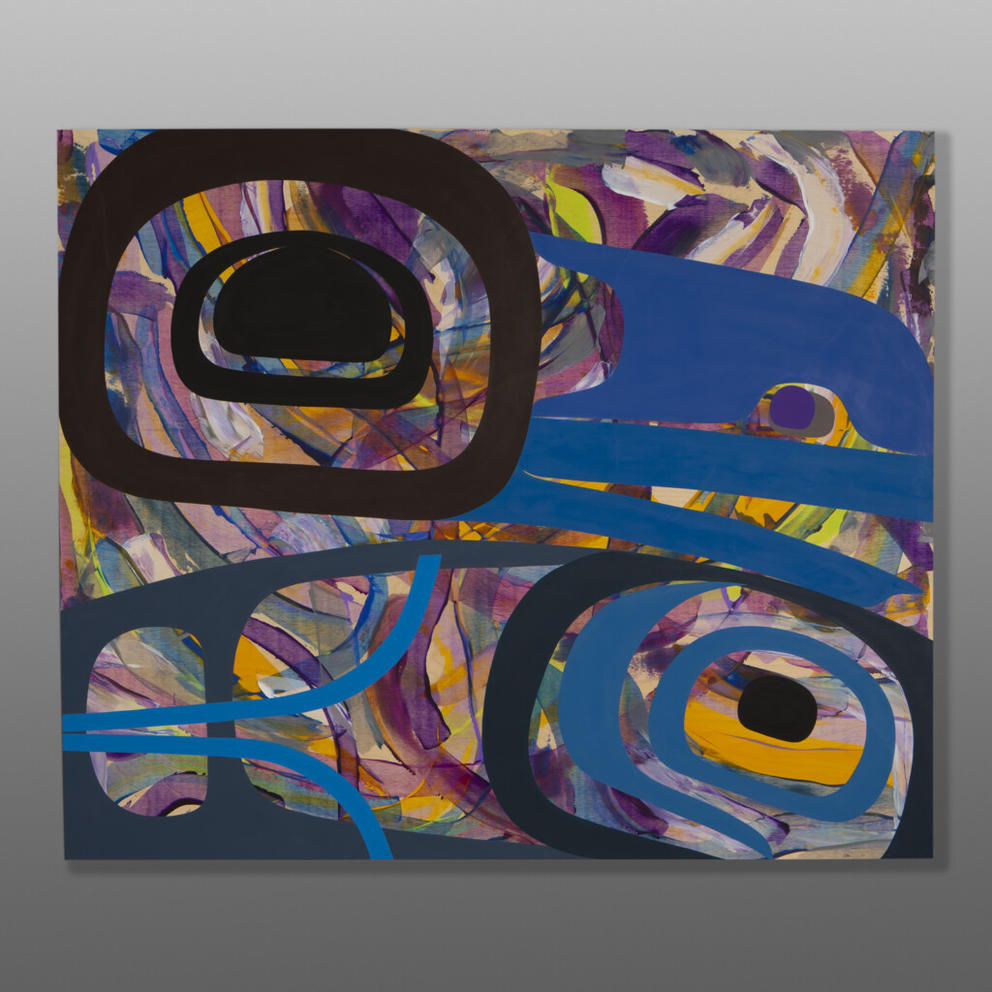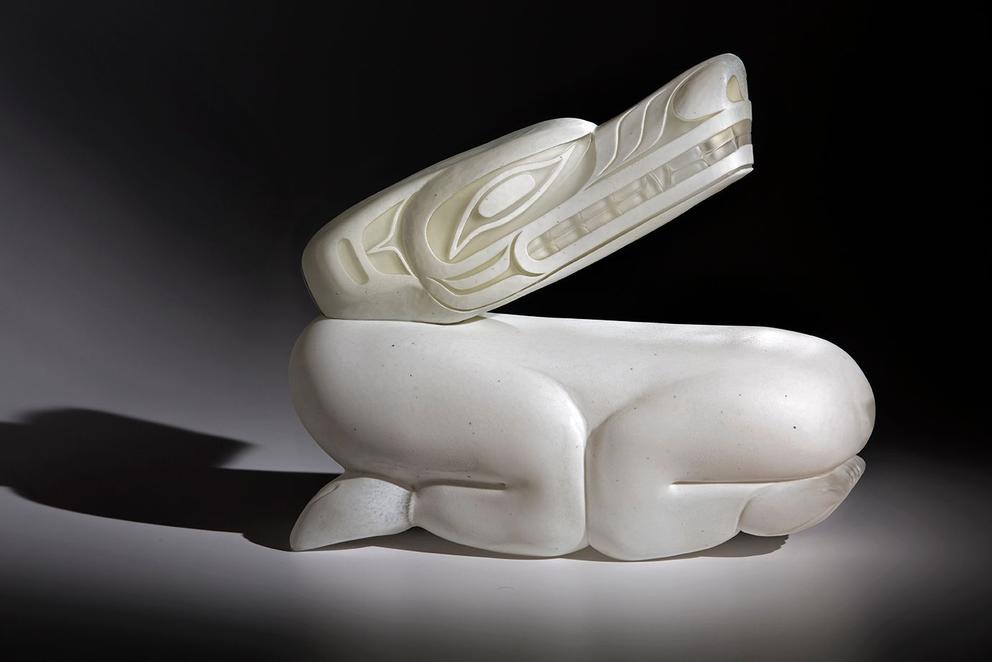Pronounced “all-all,” the Lushootseed word means “home.” It’s also the name of the new Chief Seattle Club housing facility in Pioneer Square with 80 units for mostly Native, formerly unhoused residents. The cafe — which recently announced its grand opening: Nov. 29 — sits at the base of the building, and is intended to be a gathering place for residents and the public. The evolving menu will be rooted in Indigenous foods (Bison barbacoa tacos, blue corn mush with wojape, a “three sisters” wild rice grain bowl), but ʔálʔal is also a new home for Native art.
ArtSEA: Notes on Northwest Culture is Crosscut’s weekly arts & culture newsletter.
The street-facing windows are adorned with a translucent swimming-salmon design by Makah artist Micah McCarty, whose Makah name is Hawt’wilth’iayatuk. The fish are cleverly placed below an image of canoers built into the facade, so it’s as if we’re seeing the salmon below the paddlers. Inside, a school of glass-blown fish by Lummi artist Dan Friday swims across the ceiling. Decorative lighting comes in the form of Friday’s vermillion glass spheres, which he and staff refer to as “salmon roe” (of epic proportions).
Chief Seattle (or Si’ahl) is at home here too, draped in deep red robes at the center of a large 3D mural-collage by longtime Seattle storyteller and artist Roger Fernandes, citizen of the Lower Elwha S’Klallam. Called “Changing of Worlds,” the piece is based on a Chief Seattle quote — “Death, did I say? There is no death, only a change of worlds” — and features an eagle, basketry, Mount Rainier, a canoe and salmon, all symbols of the place that has been home to Coast Salish people for eons. Once up and running, ʔálʔal Cafe will also host rotating exhibits of Native art. For now, keep an eye on Instagram for updates.
Speaking of “changing worlds,” it’s a curious feeling to come upon an overturned canoe lodged high in the trees. If you look at it long enough, you start to think maybe you’re the one who is upside down. I experienced this topsy-turvy sensation last week, when I visited Micah McCarty’s new installation on the Seattle Center grounds (he’s the artist who contributed the swimming salmon to ʔálʔal Cafe).
“Sojourners Shelter in Time Canoe” (up through January) is a Coast Salish canoe carved from a cedar log and painted in red and black. It looks like it fell from the sky — or did it leap out of water? — and got caught in some branches near the Mural Amphitheater. It’s suspended next to a vertical piece of Native cedar art, the “Seattle Center Totem,” by Duane Pasco, Victor Mowatt and Earl Muldon from 1970. McCarty (a Makah Hereditary Custodian, Master Carver and former Tribal Chairman) says his artwork recalls a Makah story about canoe sojourns, and how the travelers protected themselves along the journey by carrying overturned canoes above their heads.
Indigenous stories are all around us in the Pacific Northwest, imbued in our waterways and mountaintops and earth underfoot. This month you can familiarize yourself with a few more via a variety of art exhibits.
Recently opened at the Burke Museum, Body Language: Reawakening Cultural Tattooing of the Northwest (through Apr. 16) showcases Indigenous body art past and present. As the exhibit reveals, 19th-century missionaries and federal potlatch bans both worked to suppress First Nations’ body art traditions. But for the past 10 years, Canadian tattoo artist Dion Kaszas of the Nlaka’pamux nation has been working to revive the art of Indigenous tattooing.
Kaszas curated this show — first created for the Bill Reid Gallery of Northwest Coast Art in Vancouver, B.C. — to highlight several distinct tattoo traditions as reflected in cultural artifacts and contemporary art. “The erasure of our identity, including our tattoos, is part of [the] imperialist, colonialist project,” Kaszas told The Vancouver Sun upon the exhibit’s debut in 2018. “We’re reaching back into the past to bring it into the present to take into the future.”
Steinbrueck Native Gallery near Pike Place Market is featuring a new show of work by Vancouver B.C.-based Oweekeno artist Steve Smith, whose Indigenous name is Dla'kwagila and who last year became the first Indigenous artist to win the Global Eye Award at the StART Art Fair in London. For Harmony in Nature, Smith combines eye-popping acrylic colors with traditional formline shapes and bold graphic design to create his own take on bringing the past into the present (and future).
At Stonington Gallery, Fluid in Nature continues, showcasing works by artists Preston Singletary (Tlingit), Dan Friday (Lummi) and Raven Skyriver (Tlingit) — three stars of the Northwest Native Glass Art movement. I wrote about the show (and my affection for Skyriver’s sculpted glass “Marine Iguana”) last month for Indigenous People’s Day. If you’ve still been meaning to get there, you have through Nov. 26. And mark your calendars: Next up at Stonington is Unmasked (Dec. 1 - 31), a group show of contemporary masks by Indigenous artists that considers both Native traditions and the urgent role masks have served globally over the past several years.
And at the Henry Art Gallery, just inside the entrance you’ll find this was a densely wooded hill (evolving through March 2023). A meditative space by local artists Satpreet Kahlon (who led the project), Asia Tail and Kimberly Corinne Deriana of the yəhaẃ Indigenous Creatives Collective in Seattle, the installation features an arcing mobile of collected objects old and new — a single earring, a tin jingle, shells, rocks, beadwork — that holds meaning for the artists individually. Woven together (and augmented with items from the local community over time), the objects start to paint a larger picture of loss and grief. Sit on a tree stump amid the oyster shells and consider the show’s questions: “What is the shape of mourning? What is the sound of a memory?”
If you’re looking for a Black Friday shopping alternative, consider one of several holiday pop-up markets offering authentic Native-made arts and and crafts and assorted goods: the United Indians Native Art Market at the Daybreak Star Indian Cultural Center in Discovery Park (Nov. 19-20; Dec. 17-18); the annual Native Art Market at the Duwamish Longhouse on Marginal Way (Nov. 25-27); and from Indigenize Productions, the Seattle GAY NDN Market at Cafe Racer on Capitol Hill (Nov. 30).
Finally, a few more ways to support Native artists with your shopping dollars this month: Snoqualmie Tribe-owned artisan shop Eighth Generation in Pike Place Market (check out this beautiful “Medicine Circle” wool blanket designed by Eighth Generation founder Louis Gong); the United Indians-operated Sacred Circle Gallery in Ballard; and two Sacred Circle Gift Shops, at Daybreak Star and Sea-Tac Airport — the latter is my favorite place for a delayed-flight shopping spree.
Get the latest in local arts and culture
This weekly newsletter brings arts news and cultural events straight to your inbox.






